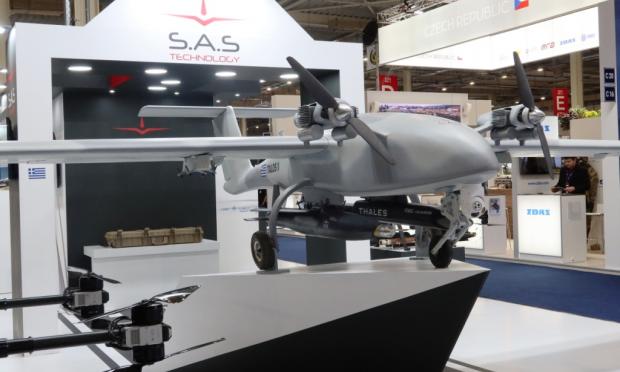At the EDEX 2023 international defence exhibition, Spirit Aeronautical Systems (SAS Technology), a Greek company founded in 2020, presented the Aihmi AHM-1X, an unmanned aerial system (UAS) developed to extend the range of 2.75-inch (70 mm) missiles.
The company considers the Aihmi AHM-1X as a potential weapon for the Sarisa SRS-1A armed drone, which completed a second test in July 2023, equipped with 70 mm missiles.
The Greek Aihmi AHM-1X roving ammunition involves a 70 mm rocket
The initiative behind SAS Technology's Aihmi AHM-1X missile aims to enhance the safety of both manned and unmanned rocket-armed platforms on the battlefield.
This missile addresses the growing threat to helicopters and UAVs posed by developments in very short-range air defence systems and the development of vehicles with more powerful guns.
These developments, together with anti-UAS systems, have also made guided or unguided missiles vulnerable to ground-based air defence systems, even at the tactical level.
To meet this challenge, SAS Technology has partnered with Thales to develop an aircraft chassis and to increase the range of the 2.75-inch missiles.
The resulting system, called Aihmi, spearhead in Greek, takes the form of a UAS with a high wing that has an electric motor at the rear that powers a two-blade propulsion propeller.
Optionally, it can also operate as a glider without any propulsion system.
The feature is the insertion of a 2.75-inch (70 mm) rocket into the fuselage of the UAS at the front.
The entire system is 1.82 m long, with a wingspan of 1.98 m.
Prior to launch, the wings fold back along the fuselage and open immediately after the rocket is launched.
Total weight is 16 kg, with a payload of 12 kg represented by the 70 mm rocket itself, while the aircraft's frame is mostly made of carbon fiber, notable for its potential radar signal interception, enhancing stealth capabilities.
The engine battery allows 15 minutes of powered flight at speeds of up to 140 km/h, after which the system switches to a glide approach.
The glide ratio is between 13 and 15, depending on the launch altitude above the ground.
Guidance is provided by an inertial GPS system.
If equipped with guided munitions, the Aihmi AHM-1X uses a reflected laser beam from another system in the terminal phase.
At this point, the warhead is armed and once it enters within 7 km of the target, the missile is fired.
The missile then travels to the point of impact, with a typical circular error probable (CEP) of less than 1 meter.
For unguided missiles, the Aihmi missile follows a similar trajectory, allowing the operator to select the target using a two-way data link.
The silent approach, once the electric motor has completed its operation, minimizes the errors associated with unguided rockets.
According to the company, when the missile is launched from an altitude of 1,000 m above the ground, the Aihmi AHM-1X in the propulsion version will cover 45 km before initiating a 15 km gliding approach as a Stand-Off Loitering Munition (SOLM ) system.
In wind-only mode, the autonomy is reduced to 15 km from the same altitude.
SAS Technology considers the Aihmi AHM-1X as a potential weapon for the SRS-1A Sarisa armed drone, which has a 25 kg capacity, allowing it to carry a Stand-Off Loitering Munition (SOLM), while the Thalos II fixed-wing UAS can accommodate up to four AHM-1X.
These are two future Greek-built weapon systems that will man the Greek Armed Forces in response to the Turkish mega-programme of small and medium-altitude unmanned aircraft.




